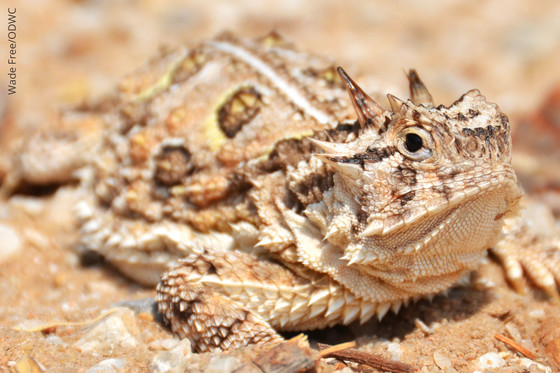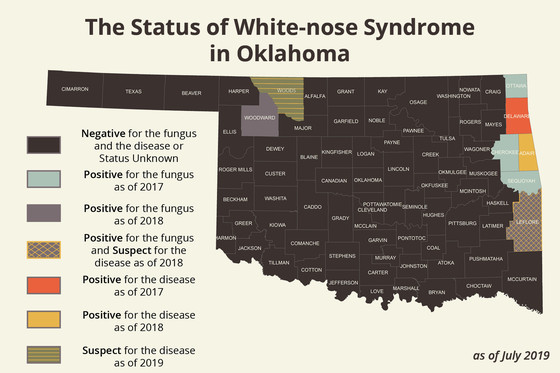Tulsa Woman Kicks off Retirement from Cricket-filled Career with … Cricket Surveys
Peggy Hill, professor emerita with the University of Tulsa, may be recently retired, but that hasn’t stopped her from continuing to study nature or from contributing to science.
After a career dedicated to training high school and college students, and researching prairie insects and other interests, she’s launched herself back into the field by partnering with the Wildlife Department and two former students to learn more about where the rare prairie mole cricket can be found in our state.
Learn about Hill's surveys for a rare prairie insect
Species Spotlight: Great Plains Narrow-mouthed Toad
Built for burrowing, narrow-mouthed toads have a pointed snout and a narrow head that gives them a somewhat unusual shape. These toads are typically found under rocks on hillsides (occasionally in tarantula burrows) but visit temporary wetlands, ditches and flooded fields during spring and early summer to mate and lay eggs. Narrow-mouthed toads rarely exceed 1.5 inches in length and can be recognized by their nasal bleating call.
Learn more in the Wildlife Department's online guide

Native Plants of Black Mesa on Oklahoma Gardening
Summer flowers are blanketing the shortgrass prairie, providing color and photo opportunities for visitors and habitat for many species of wildlife. Botanical specialist Amy Buthod with the Oklahoma Biological Survey reveals some common blossoms that may brighten your next road trip to the Oklahoma Panhandle.
Tour the plants of Black Mesa with Oklahoma Gardening

Wanted: Texas Horned Lizard Reports
Whether you call them horned frogs, horned toads, or horned lizards, the Wildlife Department wants to know where you’re seeing one of our state’s most familiar reptiles.
With your help the Wildlife Department can keep tabs on this species of greatest conservation need; identifying areas where it is still often found, or areas where it hasn’t been reported for a number of years.
Share your sightings with the Wildlife Department

Woods County Cave White-nose Syndrome Suspect
Bats in a privately owned, Woods County cave were recently tested and diagnosed suspect for white-nose syndrome, a disease that only affects bats. Forty percent of the 25 bats sampled in the cave were inconclusive for the fungus that causes white-nose syndrome, most likely because the results were lower than the standardized laboratory-defined criteria. Even so, signs of the disease – significant wing damage, visible fungus, and fluorescence under ultraviolet light – were evident on individual bats. Samples were sent to the USGS National Wildlife Health Center in Madison, Wisconsin for analysis.
Caves in at least eight Oklahoma counties are now thought to be infected with the disease or its fungus precursor.
The Wildlife Department has been a part of the national white-nose syndrome response since 2010, along with Rogers State University, University of Central Oklahoma, University of Science and Arts of Oklahoma, Oklahoma State Parks, the U.S. Fish and Wildlife Service, East Central University, the Karst Research Institute and caving organizations. Biologists from Kansas Wildlife, Parks and Tourism also assisted with this winter’s surveillance.
Learn more about white-nose syndrome at wildlifedepartment.com
Calendar of Events
Bird Walk
August 3
Oxley Nature Center, Tulsa
A Wetland at Night
August 10
Hackberry Flat Center, near Frederick
NWTF Wildlife Conservation Field Day
August 17
Burneyville
Rewilding Oklahoma
August 28
OKC Zoo, Oklahoma City
|